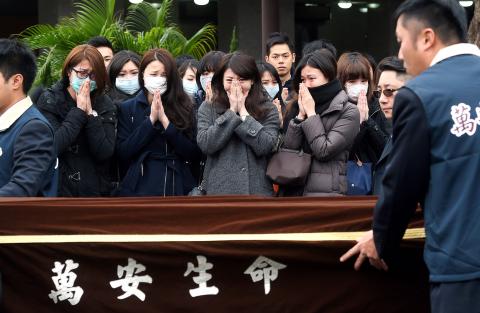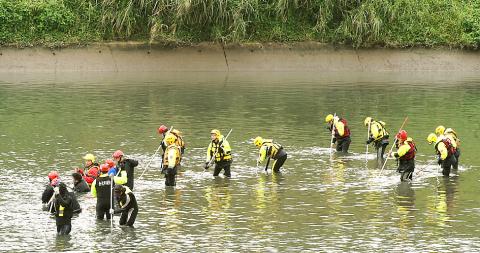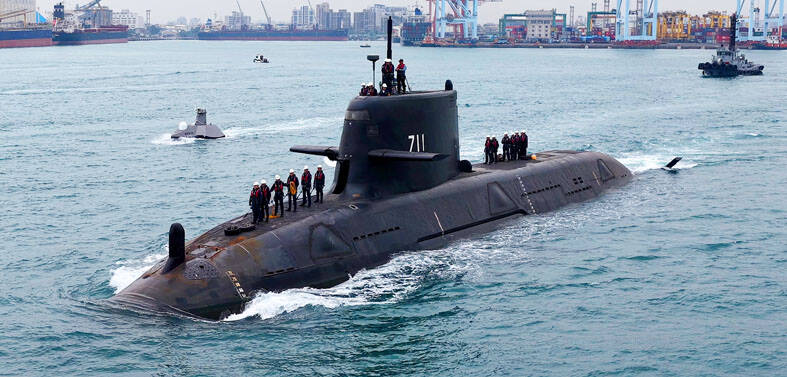Government agencies nationwide are to fly flags at half-mast today, mourning the victims of the TransAsia Airways Flight GE235 crash on Wednesday last week, the Executive Yuan said yesterday.
The ATR 72-600 turboprop aircraft crashed into the Keelung River (基隆河) in Taipei just minutes after taking off from Taipei International Airport (Songshan airport).
Of the 58 people on board, including five crew members, 40 have been confirmed dead, while 15 survived and three remained missing as of yesterday.

Photo: Chien Jung-fong, Taipei Times
Also, the Civil Aeronautics Administration (CAA) said that rescuers have continued their mission at 22 key areas identified through sonar and with metal detectors, adding that the Ministry of Transportation and Communications has dispatched large cranes and platforms to deliver the wreckage of the aircraft to Songshan Air Force Base.
The work has taken a toll on rescuers, as many have been reported getting colds after working in low temperatures. The Taipei Fire Department said that it is seeking assistance from rescuers in central and southern Taiwan.
Meanwhile, the Aviation Safety Council yesterday confirmed that the China Aviation Accident Investigation Center plans to send three representatives to Taiwan to join the council in investigating the cause of the accident.

Photo: Liu Hsin-de, Taipei Times
Council executive director Thomas Wang (王興中) said this would be the first case investigated by both Taiwanese and Chinese investigators, adding that the preliminary crash report should be finished before this month’s Lunar New Year holiday.
Wang added that the council’s investigator would preserve aircraft wreckage after examining it with aviation experts from France.
The most crucial evidence to preserve would be the engines, whose functions and the connections to the computer system will be under close scrutiny, Wang added.
Meanwhile, responding to questions about whether it took too long to demolish a gate on an embankment along Keelung River to enable search operations, Taipei Mayor Ko Wen-je (柯文哲) yesterday said he did not intend to criticize anyone’s performance, but that he thought that there is room for progress.
“I am a very strict supervisor, but I think all the municipal government employees have done a good job in the rescue efforts,” Ko said. “It is just that no one thought there would be a need to demolish the water gate to allow heavy machinery to move in, so I am sure the Department of Public Works will review the entire incident and think about whether to alter the design.”
Taipei Department of Public Works Director Peng Jhen-sheng (彭振聲) said the time required to demolish the water gate was not a crucial factor that delayed rescue efforts, which were influenced by the interplay of a number of factors, including poor soil quality and rain.
Flags flew at half-mast in September 1999 after an earthquake in central Taiwan killed more than 2,400 people and in August 2009, after 681 people died and 18 went missing after Typhoon Morakot.
The most recent period of national mourning was in August last year, after gas pipeline explosions in Kaohsiung killed 28 people and injured more than 300 on July 31 and Aug. 1 and the July 23 crash of a TransAsia ATR 72 in Penghu County that left 48 people dead.

NUMBERS IMBALANCE: More than 4 million Taiwanese have visited China this year, while only about half a million Chinese have visited here Beijing has yet to respond to Taiwan’s requests for negotiation over matters related to the recovery of cross-strait tourism, the Tourism Administration said yesterday. Taiwan’s tourism authority issued the statement after Chinese-language daily the China Times reported yesterday that the government’s policy of banning group tours to China does not stop Taiwanese from visiting the country. As of October, more than 4.2 million had traveled to China this year, exceeding last year. Beijing estimated the number of Taiwanese tourists in China could reach 4.5 million this year. By contrast, only 500,000 Chinese tourists are expected in Taiwan, the report said. The report

SHIPS, TRAINS AND AUTOMOBILES: The ministry has announced changes to varied transportation industries taking effect soon, with a number of effects for passengers Beginning next month, the post office is canceling signature upon delivery and written inquiry services for international registered small packets in accordance with the new policy of the Universal Postal Union, the Ministry of Transportation and Communications said yesterday. The new policy does not apply to packets that are to be delivered to China, the ministry said. Senders of international registered small packets would receive a NT$10 rebate on postage if the packets are sent from Jan. 1 to March 31, it added. The ministry said that three other policies are also scheduled to take effect next month. International cruise ship operators

Temperatures are forecast to drop steadily as a continental cold air mass moves across Taiwan, with some areas also likely to see heavy rainfall, the Central Weather Administration (CWA) said. From today through early tomorrow, a cold air mass would keep temperatures low across central and northern Taiwan, and the eastern half of Taiwan proper, with isolated brief showers forecast along Keelung’s north coast, Taipei and New Taipei City’s mountainous areas and eastern Taiwan, it said. Lows of 11°C to 15°C are forecast in central and northern Taiwan, Yilan County, and the outlying Kinmen and Lienchiang (Matsu) counties, and 14°C to 17°C

STEERING FAILURE: The first boat of its class is experiencing teething issues as it readies for acceptance by the navy, according to a recent story about rudder failure The Hai Kun (海鯤), the nation’s first locally built submarine, allegedly suffered a total failure of stern hydraulic systems during the second round of sea acceptance trials on June 26, and sailors were forced to manually operate the X-rudder to turn the submarine and return to port, news Web site Mirror Daily reported yesterday. The report said that tugboats following the Hai Kun assisted the submarine in avoiding collisions with other ships due to the X-rudder malfunctioning. At the time of the report, the submarine had completed its trials and was scheduled to begin diving and surfacing tests in shallow areas. The X-rudder,